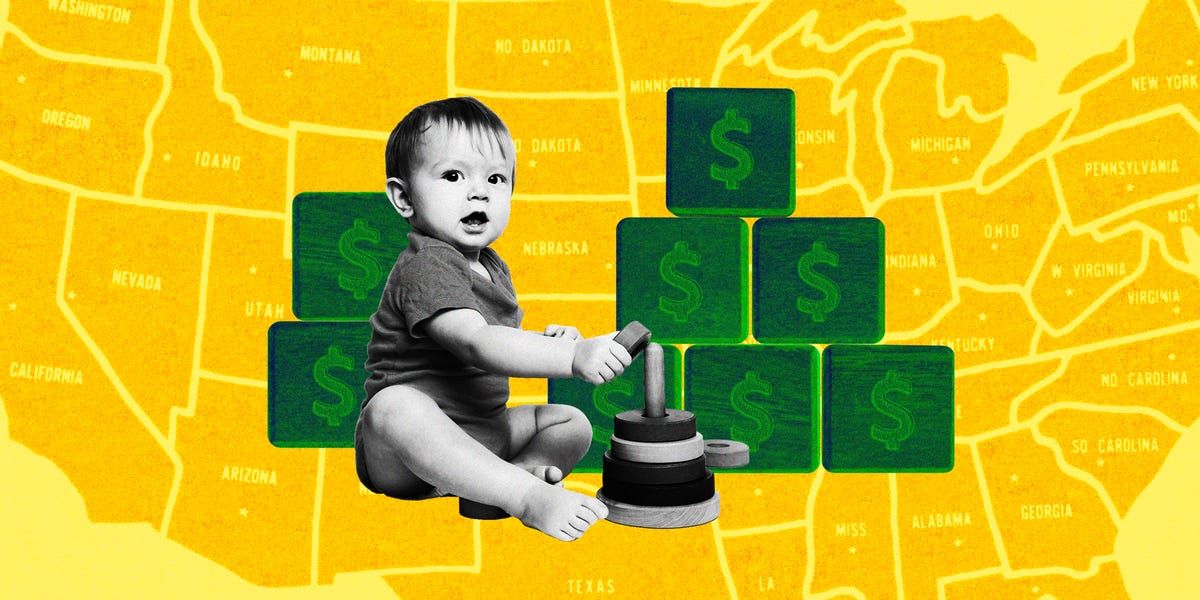The Most Expensive and Most Affordable Cities for Childcare in the US
Parents spend years saving to send their kid to college. In order to give their child the best chance to succeed in life, parents open up special savings accounts, put in extra hours of overtime, and make constant financial sacrifices. While the financial burden of college has spawned an entire industry of planners, advisors, and experts to help navigate the process, for many parents there is a similarly costly part of childrearing that comes with much less of a runway: childcare.
The cost of childcare for young children has exploded in recent years. In fact, in 34 US states the cost to send an infant or toddler to a childcare center is higher than tuition at an in-state public university. For parents relying on in-home care, the costs are even higher. The problem has gotten particularly acute in the last few years — from 2018 to 2020 the cost of childcare increased 41% on average, from $9,977 to $14,117 annually, and is now at an all-time high.
Millions of Amerians are struggling with the rising costs of childcare, but the pain also varies widely depending on where you live. In March, the Department of Labor released for the first time county-by-county childcare-spending data. My colleagues and I at American Inequality, a data-exploration project that spotlights social inequities, broke down the data to uncover what was fueling the rocketing costs of childcare. We found a startling divide: While parents in a few counties are spending only 5% of their income on childcare, many more are spending almost half their paychecks to make sure their children are properly looked after.
The reasons for these differences are equally as stark. The most expensive counties generally have fewer childcare workers or the state doesn't provide enough financial support for low-income families. In other counties, lax state regulations for childcare can drive down costs, but the quality of the programs can suffer in turn. In some cases, parents simply don't know the options out there for them, which leaves money on the table each year.
A $122 billion problem
There may be serious regional differences, but there is one near-universal truth about the cost of childcare: It's too damn high. The US Department of Health and Human Services considers childcare "affordable" if it costs less than 7% of a family's income. But nearly two-thirds of parents, including 95% of low-income parents, spend far more than that. And only 2% of counties in our analysis fell within this limit, meaning that by the government's definition, childcare is unaffordable in 98% of counties across the country.
While costs have been growing for decades, the pandemic brought new challenges that made the crisis even worse. For one, many daycare workers were pushed out of the industry by mounting health risks and painfully low compensation — approximately 100,000 workers decided to move on to other industries over the past three years. Unable to find people willing to work under those circumstances, many childcare centers shut down and left parents in childcare deserts with few other options. Many of these parents are forced to turn to in-home childcare, which costs nearly $36,000 a year on average, 39% more than the average cost of a childcare center.
The high cost of childcare not only weighs on parents' pocketbooks, it also has downstream effects for their own employment opportunities — particularly for women. The new Department of Labor data shows that when the cost of childcare rises by 10% in a county, 1% of moms in that area leave the labor force. The pandemic provided a perfect example of this dynamic: 2 million women left the workforce and haven't returned, citing childcare costs as the No. 1 reason they aren't returning to work. Even in areas where women earn higher wages, the data still shows that increases in childcare costs drive mothers out of the workforce.
Being forced out of the labor market is not only a strain on the families who are directly affected, but the loss of workers also weighs on the rest of us. At a time when the economy is in dire need of more workers, losing talented people because they can't afford to go to work is a serious problem. A study by the business think tank ReadyNation found that the childcare crisis costs the economy $122 billion in lost earnings, productivity, and revenue each year. American businesses alone lose $23 billion annually from parents calling out of work because they can't find care.
The most expensive states for childcare
As bad as the problem is nationwide, when you dig into the county-level data, the massive disparities become even more stark. Counties with higher levels of poverty often lack affordable care as childcare workers themselves can't afford to live on the industry's low wages. While wealthier counties tend to have more resources, fierce competition for quality care can drive prices up and ultimately consume huge portions of a household's paycheck. If we look at the percent of income that childcare consumes, it makes it easier to compare across counties and understand how Americans from Massachusetts to Mississippi are faring.
Although New York City is home to America's largest publicly funded childcare system, three of the five most expensive counties for childcare in America by share of income are found in New York City: Kings County (Brooklyn), Queens County, and Bronx County. The residents of Bronx County have it the worst — spending an average of 47% of their household income on out-of-home childcare for an infant. The ongoing challenges in the Bronx provide a perfect case study in the difficulties in delivering cost-effective, high-quality childcare.
Even though the city offers free "3K" and Pre-K, 30% of the seats for these programs remain open. The 10 neighborhoods with the highest levels of poverty are also the neighborhoods with the lowest levels of enrollment. These shortfalls seem baffling given the exorbitant cost of childcare in the area, but experts have pointed to a number of reasons for the openings, from poor program quality and poor marketing to a challenging enrollment process and staffing concerns. Beyond the systemic issues, there are also shorter-term pandemic-related problems that complicate the picture. More than 500 childcare centers shut down in the past five years as resources dried up as both public and private childcare systems shut down for two years. It's likely that families have been slow to reengage with the city's childcare systems given the extended closures and stop-start nature of the reopening. The challenges of the Bronx can be instructive for other counties across the US: Childcare needs to be affordable, but accessibility will also remain a key constraint. This holds true in rural counties that also struggle with accessibility, and parents end up paying far more for childcare as a result.
On a state level, Massachusetts takes the cake for the highest total amount spent on care per child. Out-of-home childcare for infant care in the Bay State costs $20,913 annually, or 64% more than tuition at University of Massachusetts Amherst. While Massachusetts has the second-highest median household income of any state, it also provides very few reimbursements or subsidies for childcare costs, resulting in higher costs for parents. California is the second-most-expensive state for childcare, costing parents $16,945 annually, or double the cost of average in-state college tuition.
On the other side of the spectrum is Mississippi, which has the most affordable childcare of any state, at just $5,436 per child annually. But the low cost doesn't necessarily mean the state should be a model for the rest of the US. Mississippi is able to keep costs low for two main reasons: First, the state has one of the most lax child-to-staff ratio requirements, meaning classroom sizes per worker can swell to worrisome levels. In Mississippi there could be just one staff member looking after 12 toddlers, whereas in New York the law requires three teachers for every 12 children. While larger classes can keep down costs, the federal government recommends lower ratios in order for children to receive the proper level of care. And studies have shown that programs with smaller classroom sizes and lower child-to-staff ratios have a positive impact on the quality of education. But of course, it's a trade-off: More teachers often means a higher cost for parents.
The second way Mississippi makes childcare cheaper is by paying workers the least of any state. The average employee at a childcare center earns just $8.94 an hour, or $1.69 above the state's minimum wage. While Mississippi's low wages stand out, dismal pay is a key factor for the poor state of the system nationwide — childcare workers earn $12 an hour on average and often make far less than peers with similar education levels or similar jobs. This gap is even more pronounced for Black childcare workers. As a result, staff turnover is high and there aren't enough teachers. The US has 19.3 million children who are 4 and under and 949,000 childcare workers — a ratio of 20 to 1. In Canada, where childcare workers make more, that ratio is six to one.
To address this issue, President Joe Biden signed an executive order in April aimed at raising wages for childcare workers, particularly those working at the federal childhood-education and care program Head Start, without increasing costs to parents. Existing programs that can raise wages for these workers have proven to reduce staff turnover by half, ultimately leading to lower costs at childcare centers as retention improves.
A model for the country
There doesn't always have to be a trade-off between cost and quality when it comes to childcare. There are parts of the US where local and state governments have been able to ease the financial pressure while also ensuring young kids are well taken care of. Take, for instance. Portland, Oregon. The city has developed a model that gives parents affordable and high-quality childcare that doesn't sacrifice teacher wages. In 2020, Portland passed a widely supported bill that authorized a tax on the wealthiest residents to fund a year-round childcare and preschool program. The program provides all children with six free hours of childcare per day, and children from lower-income families are eligible for up to 10 hours. Because of this benefit, parents in Portland are saving thousands of dollars every year, more parents are able to work, and since teachers are paid livable wages, children are getting higher-quality care.
Ultimately, evening out the disparities in the US and solving our childcare crisis comes down to funding. The US government spends just $500 annually per child on early childcare. Comparably wealthy countries spend about $14,436 per child. The price tag may seem high, but evidence from programs, such as the famous Perry Preschool Project in Michigan, proves that the investment is well worth it. For every $1 invested in early childcare, the US economy gains $7 in terms of reduced teen pregnancy, improved graduation rates, improved performance in school, and reduced incarceration rates. Successful programs have been able to increase students' earnings by as much as $19,800 annually by the time they reach their 30s while also decreasing the likelihood they become drug users by 33%.
"Without a lot more public spending, care for children under 5 will never be affordable," Annie Lowrey wrote last fall in The Atlantic. Existing funding programs such as the Childcare Development Block Grant, the largest source of federal funding to states, has reduced the cost of childcare by thousands of dollars each month for some parents. But so much more is needed.
Affordable childcare is good policy. Economic growth, employment, and children's outcomes can all improve when America chooses opportunity over adversity.
Jeremy Ney is the author of American Inequality, a data publication project that spotlights US inequality topics. He was previously a macro policy strategist at the Federal Reserve Bank of New York.
Source: Business Insider


